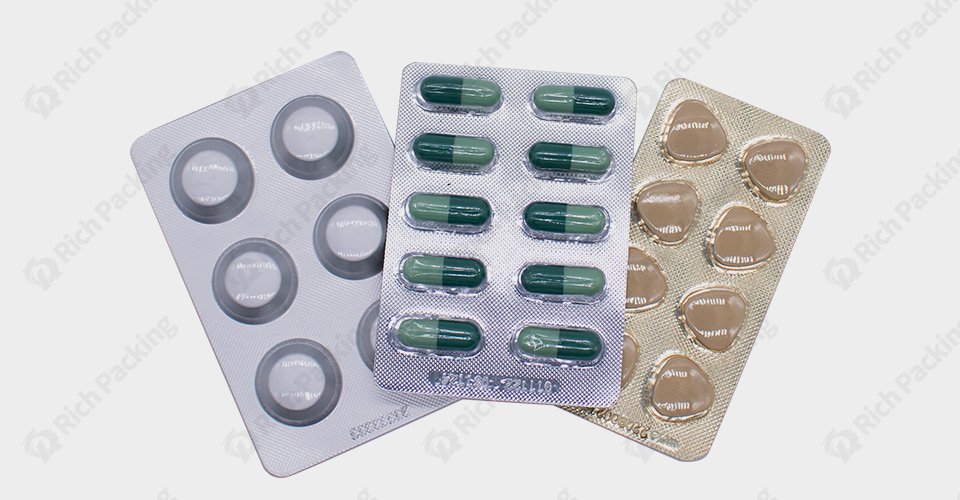Packaging machinery is one of the essential core production equipment in modern manufacturing, especially in industries such as pharmaceuticals, health products, food processing, and chemicals. Among them, blister packaging machines are widely used in the pharmaceutical industry for blister packaging of solid tablets, capsules, pills, and oral liquids. Due to the high customizability of the forming molds, blister packing machines can accommodate different shapes and sizes of pharmaceutical products. Finished capsules and solid tablets produced by capsule filling machines and tablet presses can be integrated into a production packaging line with blister packaging machines.

In this article, you will learn detailed information about blister packaging equipment, including its types, applications, and how to choose the right one.
A blister packaging machine is an equipment encapsulates products in transparent plastic or aluminum foil, commonly used for packaging pharmaceuticals, food, and small consumer goods. These machines use thermoforming or cold forming processes to shape plastic or aluminum foil into blisters, which are then used to enclose the products. This type of packaging not only protects the products but also effectively extends their shelf life, making it convenient for product display and transportation.
You may have heard the terms "thermoforming" and "cold-forming." Choosing the right forming process depends on the product's characteristics and packaging requirements.
Thermoforming blister packaging machines form blisters by heating plastic films, typically used for packaging with high transparency, commonly seen in the packaging of tablets, capsules, and similar products. This equipment heats the plastic and uses molds to shape the blisters, creating a uniform packaging structure. The main advantage is the high transparency, making it ideal for display packaging.
Cold-forming blister packaging machines use materials like aluminum foil, shaping them through a cold-pressing process. This method is particularly suited for products that are sensitive to light or prone to oxidation, such as certain pharmaceuticals. Cold-formed packaging is typically non-transparent but offers superior barrier protection, effectively shielding products from light, oxygen, and moisture.
|
Type |
Forming Method |
Applicable Products |
Advantages |
|
Thermoforming Blister |
Heating the Plastic Film |
Pharmaceuticals, Food, Supplements |
High transparency, diverse shapes |
|
Cold-forming Blister |
Cold-pressing Aluminum Foil or Plastic |
Light-sensitive medicines, oxidation-sensitive products |
Better barrier properties, suitable for sensitive products |
When choosing a blister packaging machine, production scale and automation levels are key factors.
Fully automatic blister machines operate independently from feeding to forming, sealing, and discharging, without requiring human intervention. These machines are ideal for large-scale production, enhancing efficiency and reducing labor costs, making them highly suitable for pharmaceutical factories with high production demands.
Semi-automatic machines require some manual operations, such as product loading and unloading. These machines are more suitable for small-scale production or custom manufacturing. They offer a more flexible solution for small to medium-sized businesses with lower initial investment costs.
Blister packing machines can also be categorized based on their operation mode, either continuous or intermittent, depending on production needs.
In continuous mode, the machine runs non-stop, constantly forming and sealing blisters. This mode is ideal for high-volume, single-product production lines, such as in pharmaceutical factories. The key advantage is fast production speed, allowing for large quantities to be packaged in a short period.
In intermittent mode, the machine pauses between each step, waiting for each operation to complete before moving to the next one. This mode is more suitable for production lines that require frequent adjustments, especially for diverse product types and complex packaging shapes.
Blister packaging machines are widely used across various industries, with each industry having different requirements for these machines.
Pharmaceutical Industry: In medication packaging, blister packaging machines efficiently seal tablets, capsules, and other products, ensuring that drugs are protected from contamination during transportation and storage.
Food Industry: For products like gummies and chocolates, blister packaging machines help extend shelf life while maintaining the shape and appearance of the items.
Nutritional Supplements Industry: The packaging of vitamin gummies and dietary supplements often requires blister packaging to ensure product freshness and facilitate convenience for consumers.
Consumer Goods Industry: Blister packaging also plays an important role in packing small electronic products and daily necessities, ensuring product safety while providing an appealing display.
Different production lines have varying needs, therefore, several factors should be considered when choosing a blister packaging machine.
- Production Capacity: How many products does your production line need to package each day? For high-volume production, a fully automatic blister packaging machine would be a better choice. If the production volume is smaller, a semi-automatic machine may be more economical.
- Product Type: Different products have different requirements for packaging materials. For example, the packaging processes for gummies and tablets are not the same. You need to make sure that the selected equipment can accommodate the characteristics of your products.
- Budget and Maintenance Costs: In addition to the initial investment, the maintenance costs of the equipment are also important factors to consider. The higher the level of automation, the more complex the maintenance of the equipment tends to be.
- Technical Support and After-Sales Service: The long-term stable operation of the equipment relies on the supplier’s technical support and after-sales service. Choosing a supplier with good after-sales service can extend the lifespan of your equipment.
Selecting the right blister packaging machine is crucial to your production process, especially when facing diverse products and industry-specific requirements. You can maintain a competitive edge in the market if you align your production goals and product characteristics with the appropriate machine.